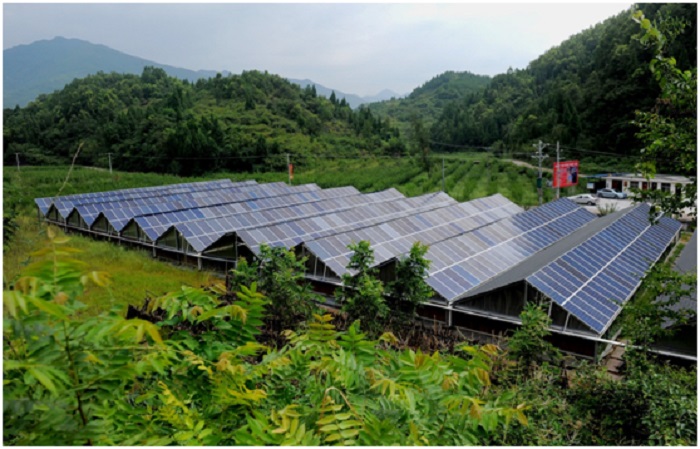



“Look at the shiny panels outside. We make money from the ’tiles,'” said Wan Chunmei, an impoverished resident in Zhailiang village, Shangwu township, Wangcang county of Guangyuan, southwest China’s Sichuan province, when she arrived at a greenhouse one kilometer from her home to prepare the soil.
The tiles she said are photovoltaic panels on the roof of her greenhouse. They were a part of the first photovoltaic-agriculture program launched in Sichuan province, which started with an investment of 2.5 million yuan ($381,750) from the Science and Technology Department of Sichuan Province and the government of Wangcang county in 2016.
“Our village finally bid a farewell to power shortage given the upgraded rural power grid and these photovoltaic greenhouses,” said Gou Junde, party chief of Zhailiang village. According to him, electricity was always in short supply when power demand peaked in summer. “Villagers had to go to the mountains to fetch firewood for cooking when summer came,” he told the People’s Daily.
To alleviate the situation, Zhailiang village resorted to green energy. Located in a valley, the village is covered by sunlight for 1,352 hours in total each year, and the longest sunshine duration in the summer can reach 14 hours per day.
Under the assistance offered by the Science and Technology Department of Sichuan Province, the village built 11 photovoltaic greenhouses that are able to generate 226,800 KWh of electricity each year.
“The volume not only covers the demand of our village, but also helps us gain extra income once sent to other places,” Gou said.
As the first village in the province to launch photovoltaic-agriculture program, Zhailiang encountered obstacles when starting the mode.
Residents in the village lived on farming for generations, so the innovative development mode was not accepted well in the first place.
“Some villagers worried that they might lose their source of income once the land was transferred,” said Yuan Yi, mayor of Shangwu township. To eliminate the concerns of the residents, village officials visited door to door to persuade them. “Two notebooks were used up,” Yuan said.
Zhailiang village organized 65 impoverished households and established a photovoltaic power generation cooperative. These households plant edible fungi in the greenhouses, and the profit is shared according to their contribution.
“The mushrooms are ready to hit the market now,” said Zhang Kuosheng, first secretary of Zhailiang village in charge of poverty alleviation work. He’s quite confident about the industry’s prospects. According to him, the edible fungi planted in the greenhouses are expected to generate revenue of 70,000 yuan this year, and each impoverished household can receive an extra bonus of 3,250 yuan from power generation.
Wangcang county is currently working to promote the construction of photovoltaic power generation bases to further increase the ratio of renewable energy in total generating capacity. By the end of this year, the county will have built 16 photovoltaic power stations in its villages, which will increase 1,000 yuan of income for each resident every year.


The Humanitarian Service Diamond Awards has.
A Chinese Company, Inner Galaxy Steel.


The Programme Coordinator, Regulatory, Compliance and.


A Non-Governmental Organization (NGO), Committee for.
The Trustfund Pensions Limited has chided.


The House of Representatives Committee on.
The China General Chamber of Commerce.


Senator Chuka Utazi who represented Enugu.


An Abuja based Legal Practitioner, Ugochukwu.


The African business community in Yiwu,.
Leave a Comment